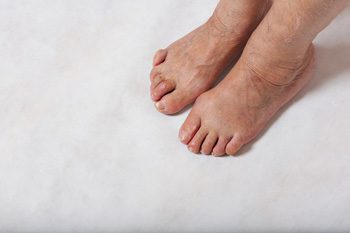
Hammertoe is a foot deformity where one or more toes bend abnormally at the middle joint, often leading to pain, stiffness, and difficulty wearing shoes. Older women are more likely to develop hammertoes due to years of wearing high heels, narrow-toed shoes, and unsupportive footwear that force the toes into unnatural positions. Over time, the muscles and tendons in the toes tighten, making the deformity permanent. Genetics, foot structure, and biomechanics also play a role, with women more prone to bunions and flat feet, both of which increase hammertoe risk. The condition often worsens with age, often leading to corns, calluses, and joint pain. Preventative measures include wearing roomier shoes with proper arch support and performing toe-stretching exercises. If you have a hammertoe and it becomes painful or rigid, it is suggested that you see a podiatrist for appropriate treatment.
Hammertoes can be a painful condition to live with. For more information, contact Afsaneh Latifi, DPM of Lenox Hill Podiatry. Our doctor will answer any of your foot- and ankle-related questions.
Hammertoe
Hammertoe is a foot deformity that occurs due to an imbalance in the muscles, tendons, or ligaments that normally hold the toe straight. It can be caused by the type of shoes you wear, your foot structure, trauma, and certain disease processes.
Symptoms
- Painful and/or difficult toe movement
- Swelling
- Joint stiffness
- Calluses/Corns
- Physical deformity
Risk Factors
- Age – The risk of hammertoe increases with age
- Sex – Women are more likely to have hammertoe compared to men
- Toe Length – You are more likely to develop hammertoe if your second toe is longer than your big toe
- Certain Diseases – Arthritis and diabetes may make you more likely to develop hammertoe
Treatment
If you have hammertoe, you should change into a more comfortable shoe that provides enough room for your toes. Exercises such as picking up marbles may strengthen and stretch your toe muscles. Nevertheless, it is important to seek assistance from a podiatrist in order to determine the severity of your hammertoe and see which treatment option will work best for you.
If you have any questions, please feel free to contact our office located in New York, NY . We offer the newest diagnostic and treatment technologies for all your foot care needs.




